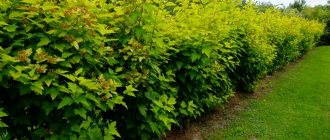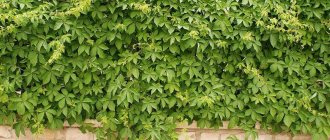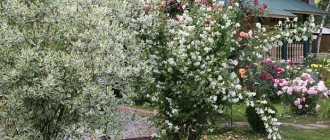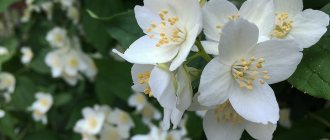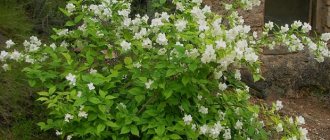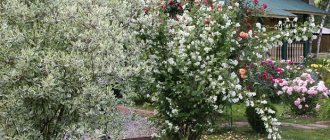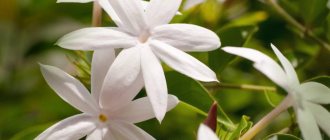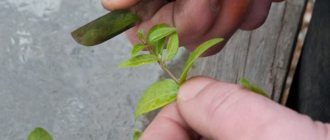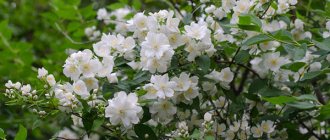What does mock orange go with in the garden?
Mock orange is often mistakenly called jasmine due to the similar aromas of the two shrub species. In fact, these are different cultures. Real jasmine is almost never found in Russian gardens, but mock orange is known to everyone. However, the name has stuck so well that many gardeners know this plant as garden jasmine.
In the garden, mock orange looks great with decorative deciduous and flowering shrubs. These plants make excellent shrub mixborders. It has become popular among landscape designers to create themed plantings. Photos of white gardens with mock orange are fascinating, the design of which combines white-flowered shrubs with hydrangeas, viburnum, and derain, which also have white flowers.
Among climbing plants with garden jasmine, clematis, actinidia, and climbing roses look good.
Large trees with bright leaves are a suitable background for all varieties of mock orange. Its autumn yellow foliage in combination with the purple leaves of maple or hazel looks especially picturesque in landscape design. The dark green crown of conifers also favorably sets off its shoots covered with white flowers.
Garden jasmine looks great, especially its tall varieties, near ponds; it is often planted near gazebos, benches and other small architectural forms. Snow-white bushes of flowering mock orange invariably attract attention against the background of red brick walls or buildings of contrasting colors.
Types of mock orange
In nature, 50-70 species are known that grow in temperate latitudes of Eurasia and America. All mock oranges are spreading deciduous shrubs; in nature they grow in the undergrowth of broad-leaved and mixed forests, in clearings, along the edges and among thickets of bushes, often singly or in small groups.
Crown mock orange (Philadelphus coronaris)
Mock orange crown is the most common type of mock orange in landscaping. Found in gardens and parks everywhere. The height of the bush is up to 3 m. It grows quickly, longevity is 30 years. The leaves are large and serrated. Blooms profusely and for a long time, 20 days. The flowers are very fragrant, up to 3.5 cm in diameter. In autumn the leaves turn yellow. This is the most winter-hardy species, withstanding frosts down to -25 C. We list the most interesting and popular varieties:
Mock orange "Aurea" is a showy variety with golden yellow leaves. For planting, you must choose a sunny place, since in the shade the golden color of the leaves disappears and becomes normal green.
Mock orange "Variegata" - a variety with variegated leaves, white and yellow spots make the crown contrast with other shrubs.
Mock orange crown "Anomala" (Anomala) - the variety is distinguished by a compact, elegant crown shape, no higher than 1 m in height. The flowers have a pink center inside the corolla.
Schrenk's mock orange (Philadelphus schrenkii)
Schrenk's mock orange blooms in Moscow at the end of May, one of the first among other species. At this time, it is abundantly covered with white fragrant flowers, collected 7-9 pieces in dense short inflorescences.
The flowers are quite large, up to 4 cm in diameter, flowering duration is 25 days. The homeland of this species is the Far East, Korea, China. It can be distinguished by its hairy young shoots and pubescent flower columns. In our conditions, the bush grows up to 2 m in height, has characteristic ovoid-shaped leaves, narrowed at the top. The species is winter-hardy, withstands frosts down to – 25 C.
Small-leaved mock orange (Philadelphus microphyllus)
Small-leaved mock orange came to us from another part of the world, its homeland is North America. It blooms at about the same time, at the end of May. A low-growing, multi-tiered bush with an openwork crown. The shoots are thin, shiny, the leaves are not large, lanceolate. Strawberry-scented flowers completely cover the bush during flowering. This species is the ancestor of the most beautiful decorative forms and varieties.
Downy mock orange (Philadelphus pubescens)
Fluffy mock orange, on the contrary, blooms late, in the second half of July - early August. It got its name from the lower pubescence of the leaves. It grows naturally in the forests of North America and was introduced into cultivation quite a long time ago (since 1800). This is a tall shrub, up to 3 m tall, with a crown diameter of 1.7 m. The flowers are almost without aroma, but they are large and collected in fairly dense clusters of 5-10 pieces.
Odorless mock orange (Philadelphus inodorus)
Mock orange is odorless. Homeland - North America. The bush reaches 3 m in height. The leaves are large, 7-12 cm. The flowers are white, odorless, up to 5 cm in diameter, collected in racemes of 3 or 5 pieces.
Mock orange "Grandiflorus" is a taller form with a tall spreading bush up to 4 m high and up to 3 m in diameter. The bark is brown. It blooms a little later - at the end of June, with large, odorless flowers up to 6 cm in diameter. The flowers are unusually beautiful - snow-white, with wide petals, forming an almost square shape in general, with very numerous stamens. It has a record long flowering period (up to 30 days). Tolerates partial shade well.
Lewis mock orange (Philadelphus lewisii)
Lewis mock orange is abundant at the end of June; the flowers are white, cup-shaped, up to 4 cm in diameter, collected in large racemes. The bush reaches 2.5 m in height.
Gordon's mock orange (Philadelphus gordonianus)
Gordon's mock orange is one of the tallest species. It can reach 4 m, and sometimes, when shaded, in search of light, it throws out branches up to a height of 5-6 m. The bark of the shoots is yellowish and smooth. The leaves are bright green, shiny, up to 8 cm, pubescent below. The flowers are pure white, slightly fragrant, up to 4.5 cm in diameter, collected in dense inflorescences of 7 or 9 pieces. It blooms in June-July annually and very profusely.
Pointed mock orange (Philadelphus satsumanus)
Pointed mock orange or Yokohama mock orange (Philadelphus yokohamae) is extremely rare in our gardens. In its homeland in Japan, it grows as a tall shrub up to 2 m high, but in cultivation its height does not exceed 1.5 m. The leaves are large and pointed. Flowers bloom in mid-June. They are small, elegant, white, collected in 5-9 pieces in dense inflorescences with a subtle, mild aroma.
Pekin mock orange (Philadelphus pekinensis)
Peking Chubushnik from Northern China and Korea has a height of up to 1.6 m. It has medium-sized foliage and original white-cream flowers up to 3 cm in diameter with a subtle aroma. The petals are wide, located in the same plane. Blooms from late June to mid-July.
Lemoine mock orange (Philadelphus lemoinei)
The parade of mock orange species is completed by the species that produced the most beautiful varieties. Lemoine mock orange is a hybrid of common mock orange and small-leaved mock orange (Philadelphus pallidus x Philadelphus microphyllus). It blooms in July for up to 20 days with pure white flowers collected in racemes and has a strong aroma. It has been used by foreign and domestic breeders to create many magnificent varieties.
Chubushnik Lemoine "Virginal" (Virginal) - the variety was obtained by Lemoine in 1909. It is distinguished by large, double, snow-white, goblet-shaped flowers up to 5 cm in diameter. The bush reaches a height of up to 2 m.
Chubushnik Lemoine "Mont Blanc" (Mont Blanc). The variety is quite stable in central Russia. Forms a tall bush (up to 1.8 m) with large leaves. The flowers are semi-double, pure white, gracefully shaped, fragrant. The petals of the lower circle are very wide, beautifully bent back, the inner ones are few, curled inward.
Chubushnik Lemoine "Alabaster" (Alabaster). Straight bush up to 2 m high, snow-white semi-double flowers, fragrant, large, collected in clusters of 7-9 pieces. The inner petals are narrower and few in number. It blooms on average 10 days later than the crowned mock orange, and for a very long time (up to 35 days).
Creating compositions depending on the type and variety of mock orange
When planning a landscape design using mock orange, you should keep in mind that some plants tolerate its proximity well, while it can suppress the growth and development of others. Thus, pear and apple trees planted in close proximity to garden jasmine grow weak, bloom and bear fruit poorly, but lilac, rose, kolkvitsia, weigela, peony, and barberry get along well with it. Many gardeners argue that the compatibility of mock orange with other plants in landscape design is difficult to predict in advance, since much depends on external factors - soil composition, lighting and other environmental features.
Attention! The choice of the type and variety of mock orange for the implementation of various design ideas is determined by the varietal characteristics of the plant, first of all, the size and shape of the crown and flowering characteristics.
For example, the Dwarf and Gnome varieties with a compact spherical crown are good for forming borders and edging flower beds.
Low (up to 120 cm) bushes of the Pompom and Chamomile varieties will look good in the foreground in plantings of multi-level crops; to form the second level of such compositions, Elbrus, Komsomolets, Moonlight with a bush height of up to 160 cm are suitable.
For the background of multi-level ensembles, you can plant tall varieties, from 200 to 400 cm, such as Zhemchug, Snezhnaya Burya, Zoya Kosmodemyanskaya. They will also look very impressive in single plantings.
Jasmine (Chubushnik)
If you choose unpretentious and beautiful shrubs for a hedge, then it is impossible to ignore jasmine. This is one of the favorite plants of Russian gardeners.
Actually, the shrub we call jasmine doesn't quite live up to its name. Real jasmine in cool climates can only be grown in a greenhouse. And in gardens they plant “mock orange”, the aroma of whose flowers is similar to true jasmine.
In order for a hedge made from this wonderful ornamental shrub to delight you for a long time with abundant flowering and a beautiful shape, constant pruning of old and dry branches is necessary. Moreover, the plant tolerates this operation well, and the young branches are already covered with flowers in the second summer.
A hedge of mock orange jasmine is winter hardy. Caring for it is the simplest and least burdensome.
Features of using mock orange in the garden landscape
In landscape design, mock orange is often combined with other flowering shrubs or crops with decorative foliage. You can use it in continuously flowering compositions, selecting types and varieties according to flowering dates. Most often, garden jasmine is planted with weigela, thuja, juniper, various types of heathers, and spirea. Ensembles with hydrangea, lilac, barberry, deutzia, and cinquefoil have become classics of landscape design. The great advantage of such compositions is their ease of care - all these shrubs have similar requirements for the place of growth and require the same care.
Jasmine and mock orange - what's the difference?
Mock orange is a common shrub that is often called jasmine. These plants are completely different species, they not only have different appearance and needs, but also belong to completely different botanical families. Therefore, it is worth taking a closer look at them so as not to make mistakes.
Jasmine
Jasmine (Jasminum) is an evergreen plant from the Oleaceae family that we usually associate with white, fragrant spring bushes. It is a climbing or erect plant. All species except jasmine are not found in our country, because most jasmines are exotic plants. Jasmine (Jasminum nudiflorum Lindl.) is a shrub with long shoots and yellow flowers, similar to forsythia flowers, almost odorless. Flowers appear in early spring from February to April. These shrubs do not tolerate large temperature changes that occur in our climate, and therefore are not suitable for year-round cultivation.
Several types of jasmine can be grown in pots, and although they are not the easiest to care for, they can sometimes be grown in apartments for a long time, for example:
- jasmine multiflorum is a creeping shrub, green leaves and white, intensely fragrant flowers that appear on the plant in December-April,
- Indian (Arabic) jasmine or sambac is a climbing shrub with white, fragrant flowers collected in umbrellas, blooming in summer from June to September.
Jasmines are easily grown as ornamentals in many warmer regions of the world. Jasmine teas and aromatic oils are prepared from several types. The flowers of this plant are also used in cosmetics and perfumes. In our country, real jasmine can only be grown in pots at home, because the plant does not tolerate low temperatures.
Chubushnik
A completely different plant is mock orange (Philadelphus), which belongs to the Hydrangeaceae family. Its white, charming flowers are a delight every spring and summer and usually smell great, but some species and cultivars are almost completely odorless. In our country, two types are mainly grown:
- Downy mock orange (Philadelphus pubescens) – odorless;
- Crown mock orange (Philadelphus coronarius).
These are shrubs of varying heights (1-5 meters) and flowering periods, but all species grown in our country are characterized by sufficient resistance to low temperatures and low cultivation requirements. Therefore, mock orange can be successfully planted in sunny and shaded areas, as well as in good or weaker soils. The bushes will grow well in different conditions, they just don’t like drought.
Mock orange hedge
Mock orange is one of the most popular shrubs for creating hedges. Fences made from it turn out to be very elegant and picturesque. Using this plant for hedges has the following advantages:
- outstanding decorative qualities;
- unpretentiousness, ease of care;
- Possibility to adjust the height by trimming.
In the photo of mock orange hedges in garden landscape design you can see options for every taste. The main thing is to choose the right type of shrub.
To create low borders in the garden or other areas, such as those in the photo, low-growing varieties of mock orange are perfect. Varieties such as Moonlight, Academician Komarov, White Bouquet and others do not require cutting and are excellent for low hedges.
The most beautiful hedges are made from mock orange, large-flowered, crown, Schrenk and Caucasian. Shrubs of these varieties can grow up to 3 m, but if necessary, the desired height can be maintained by pruning.
In order for the hedge to turn out beautiful and picturesque, and for garden jasmine to feel good, it must be planted according to certain rules:
- It is better to plant in the fall. If this is not possible, you can plant mock orange in early spring, before the buds appear;
- You can immediately root the cuttings, but it is better to plant adult seedlings that have reached the age of 2 - 3 years;
- mock orange is planted in trenches or planting holes 0.5 m deep. The same distance is maintained between plants;
- a drainage layer is poured onto the bottom;
- seedlings are buried to the level of the root collar;
- plantings are well shed.
After planting, the bushes are watered abundantly another 2–3 times with a difference of 7 days. In the future, such frequent watering will not be required; additional moisture will be needed only during particularly dry periods. Caring for a mock orange hedge is quite simple.
A year after planting the mock orange, the first fertilizing is done. For 1 part potassium sulphide take 1 part urea and 2 parts superphosphate. 2 tbsp. l mixture of these components is diluted in 10 l. water. This amount of fertilizer is used for 2 young plants. The plantings are fed with mineral complexes at the beginning of summer. The best organic fertilizer is slurry, which is diluted in water at a rate of 1:10. It is enough to apply this fertilizing once a year in the spring.
Also, mock orange hedges benefit from periodic weeding, shallow loosening and mulching with peat. Pruning is of particular importance for the decorative appearance and health of the shrub.
LiveInternetLiveInternet
Author: V.V. Kotov, candidate s. X. sciences, breeder. Photo from the author's nursery.
Hedges have always been very popular among gardeners. To create such hedges, mainly decorative deciduous shrubs are used. And mock orange is one of the few plants from which you can create a real flowering wall! Mock oranges look great in hedges, both loose and clipped. Varieties for unclipped, free-growing hedges must have the following qualities: stability in cultivation, high shoot-forming ability, beautifully shaped bush, abundant flowering. The choice of varieties for free fences is quite wide: “Airborne Landing”, “Pearls”, “Zoya Kosmodemyanskaya”, “Stone Flower”, “Komsomolets”, “Salyut”, “Snow Storm”, “Elbrus”. All these varieties are powerful and fast-growing, so 2-3 year old seedlings, after planting in a row 1 meter apart, will create an impenetrable wall after 5-6 years. A free hedge can consist of plants of one variety or of several varieties. But it is better to stick to the rule - to make a hedge either only from varieties with a compact bush shape or from wide spreading varieties. Contrast in this case is appropriate if the compact variety dominates in height in group planting or when planted in rows spaced 2-2.5 meters apart. But, combining compact and spreading bushes in a hedge will make it look tacky.
Zoya Kosmodemyanskaya. Compact, abundantly flowering variety, well suited for free-growing hedges. The bushes resemble a large blooming bouquet.
Stone Flower. A profusely flowering variety with a spreading bush. Flowers - “bells”, falling, densely cover its drooping branches.
Free-growing mock orange hedges are very impressive during flowering. They look natural in parks and large gardens. Varieties for formed hedges, in addition to the above qualities, should also have beautiful foliage, and also tolerate pruning well, and ideally, bloom luxuriantly even when trimmed.
Crown golden. Decorative leaf form of coronal mock orange. Tolerates haircuts well. The leaves in spring are golden-yellow at the beginning of summer, later yellow-green, flowering is moderate when clipped. For maximum decorative effect, a hedge of golden mock orange should be well lit, because the more light, the brighter the foliage will be.
Willow leaf. The leaves are narrow, lanceolate, reminiscent of willow. Tolerates haircuts well. Abundant flowering in a cropped form occurs in 7-8 years. It is also good in open hedges; its flowering branches (sultanas) are literally filled with flowers.
Chicks. Young leaves at the tips of the shoots are lemon-yellow, and when the temperature drops below 15 degrees, which often happens in early summer, they acquire a beautiful blush. Mature leaves are green and very dense. The color of young foliage looks beautiful in low borders up to 0.7 m high. Flowering when trimmed for 7-8 years is moderate.
It is no secret that many varieties of mock orange tolerate shearing well, but the flowering of most varieties is much weaker than in free form. However, there are exceptions: the varieties “Pearl” and “Abundant” bloom when trimmed and look almost better and more interesting than in a free form.
Abundant. The variety tolerates shearing well. It blooms luxuriantly from 7-8 years from the beginning of the formation of the hedge. The foliage is dense, dark green.
Pearl. Perfect for trimmed hedges. The variety has beautiful shiny dark green foliage. Blooms profusely when clipped from 7-8 years from the beginning of hedge formation. Very handsome.
Growing mock orange in a clipped form does not create any particular difficulties for the gardener. The place should be bright. Almost any soil is suitable for mock orange, except, perhaps, very dense or very damp swampy. In a hedge, plants are planted in one row every 40-70 cm. The greater the distance between the plants, the later they will close together, but the hedge will be more durable. For planting, it is better to use plants aged 2-3 years with a closed root system. Usually these are plants in a 2-5 liter container. Such plants quickly take root, and, most importantly, you will form them from a young age, which is very important for a hedge. It is better to plant in May-June, in which case the plants will take root well and become stronger over the course of the season. The next year after planting, immediately after the snow melts, the plants should be cut at a height of 10-15 cm (to the stump). This pruning is necessary to obtain a large number of shoots, which will later form the basis of the bush. When these shoots grow to 40 cm, we trim them, and keep the plants trimmed at this height throughout the season. This is necessary so that the shoots ripen well and gain “thickness”. In subsequent years, we carry out the first pruning in June after the shoots have grown by 30-40 cm. After pruning, the length of young branches directed vertically should not be more than 25-30 cm. Then we maintain the hedge all season at a new height of 65-70 cm Next year we again add no more than 25-30 cm to the height, and so on every year. In a few years, when the hedge reaches the height you plan, trimming in June should be done after flowering and leaving no more than 10 cm of new growth. It is important to remember that when trimming mock orange from the sides, you should avoid cutting too close to the old shoots. Excessive fanaticism in pruning mock orange is contraindicated; after all, it is not boxwood or cotoneaster.
As experience shows, mock orange hedges have an interesting, non-trivial appearance. And during the flowering period it is a real flowering wall!
Mock orange in compositions
In the garden landscape, mock orange can be present both as a tapeworm and in compositions. In single plantings, medium-sized and tall varieties with a spreading crown or drooping shoots, as well as compact mock orange trees on a trunk, look exquisite.
Mock orange is a beautiful shrub, medium- and low-growing varieties of which look advantageous in flower beds, flower beds, rockeries, alpine slides and other elements of landscape design. During the flowering period, its neutral, elegant white color goes well with the entire color palette of other plants.
Continuous flowering beds are especially popular in landscape design. You can find many photos and diagrams of such ensembles with garden jasmine for growing in the garden or in other areas. One of the ready-made options is a combination of mock orange as a central element with hybrid bergenia, tree hydrangea, Bumald spirea, and hybrid daylily. The completeness of the composition will be given by scaly and rock junipers, which do not lose their decorative properties.
Attention! When selecting plants for group plantings, it is necessary to take into account not only their decorative qualities, but also their growth conditions and the characteristics of agricultural technology.
Reproduction of mock orange
Like most ornamental crops, mock orange can be propagated both by seed and vegetative methods. However, propagation by seeds is not very popular because, firstly, it requires certain knowledge and significant time, and secondly, it does not guarantee the preservation of varietal characteristics. That is why mock orange is most often propagated by cuttings or layering.
Cuttings of mock orange are carried out in late May - early June. To do this, cut elastic 6-15 cm green shoots with leaves. In this case, the lower diagonal cut should be directed in the direction opposite to the eye and located 1-1.5 cm below the bud. The top cut should be made above the kidney. Remove the bottom leaves and cut the top ones in half.
Place the lower part of the cutting for 10-12 hours in a solution with a root formation stimulator (Kornevin, Heteroauxin, etc.). Then plant the cuttings in a container filled with a light potting mix or sand. If necessary, cover the “plantings” with a plastic cap. When leaves appear on the cuttings, you can safely plant young plants for permanent residence.
Reproduction of mock orange by layering will not cause difficulties even for inexperienced gardeners. For the event to end successfully, select a young one- or two-year-old shoot without set buds (if desired, you can use several shoots at once) and bend it to the ground. At the site of intended rooting, dig a small hole and fill it with a mixture of fertile soil, compost and sand. To speed up root formation, make small cuts on the shoot. Place the shoot in the planting hole, sprinkle with soil, secure with a metal bracket and water generously.
Never cut a branch from the mother plant!
If the shoot takes root, then after 1-2 seasons you can separate the young bush from the parent plant and replant it in a new place.
- 8 ways to propagate ornamental shrubs
Try propagating your favorite shrubs yourself – it’s not difficult at all!
Rules for care and pruning for best results
Pruning is one of the mandatory procedures for caring for mock orange. Sanitary pruning involves the annual removal of weak, diseased, broken shoots, as well as faded inflorescences. For lush flowering and aesthetic appearance, a shaping and rejuvenating haircut is carried out every year or two. Its main goal is to stimulate the growth of young shoots. With the onset of spring, old branches and the tops of strong young branches are cut off. Weak side shoots are greatly shortened. If the bushes have lost their decorative appearance, you can do radical pruning. It is carried out in 2 stages: in the first year, during spring pruning, all branches except 3-4 shoots up to 40 cm long are completely cut off and the plant is fertilized. In the second spring, 2–3 branches are left on these shoots. After this procedure, the hedge is completely restored and begins to bloom profusely after 3 years.
Rose wrinkled
This type of wild rose grows up to one and a half meters. The bush is both decorative and prickly. At the beginning of summer it is covered with lovely large red flowers and remains in this state until September. This rose can be propagated by cuttings or suckers.
The shrub does not need pruning, but from time to time you need to remove old and broken branches. However, if there is a need to rejuvenate the rose, it is enough to carry out continuous pruning - shoots appear and the next year flowers bloom on young branches. There are other types of rose hips that can be used in green hedges: needle rose, cinnamon rose, common rose. Wild species Roses are larger than garden roses, they take root more easily, do not require soil fertility, and tolerate winter frosts well.
